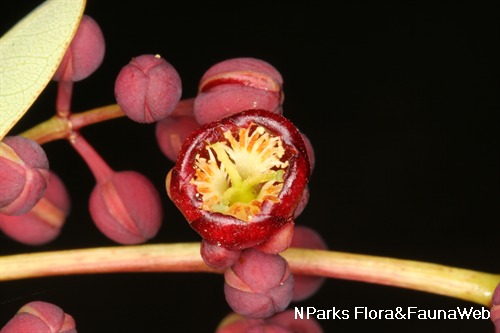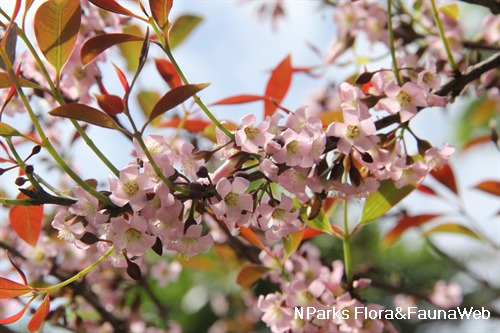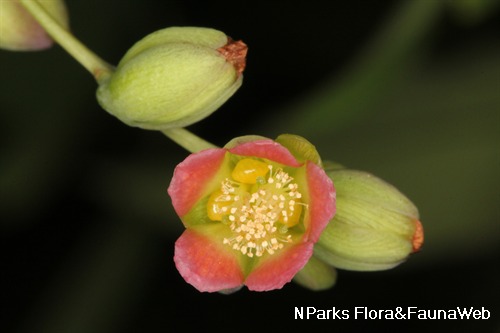
Back
Cratoxylum cochinchinense (Lour.) Blume
| Family Name: | Hypericaceae |
| Synonyms: | Cratoxylum ligustrinum (Spach) Blume, Cratoxylum myrtifolium Blume, Cratoxylum polyanthum Korth., Hypericum cochinchinense Lour. |
| Common Name: | Derum Selunchor, Yellow Cow Wood, Mampat, Baduk-baduk, Red Mempat, 黄牛木 |
Cratoxylum cochinchinense or Derum Selunchor is a deciduous shrub to tree growing between 5 - 30 m tall. It has papery to leather leaves with grey-green bloom on the underside and faintly fragrant flowers that are usually deep red coloured. The fruit is an elliptic-cylindrical capsule with sepals more than half of its length.
Name
Classifications and Characteristics
| Plant Division | Angiosperms (Flowering Seed Plants) (Dicotyledon) |
|---|---|
| Plant Growth Form | Shrub, Tree (Big (>30m), Medium (16m-30m), Small (6m-15m)) |
| Lifespan (in Singapore) | Perennial |
| Mode of Nutrition | Autotrophic |
| Plant Shape | Weeping / Pendulous |
| Maximum Height | 30 m |
Biogeography
| Native Distribution | Andaman Island, Borneo, Cambodia, China South-Central, China Southeast, Laos, Malaya, Myanmar, Nicobar Island, Philippines, Sumatra, Thailand, Vietnam and Singapore |
|---|---|
| Native Habitat | Terrestrial (Secondary Rainforest, Primary Rainforest, Freshwater Swamp Forest) |
| Preferred Climate Zone | Tropical, Sub-Tropical / Monsoonal |
| Local Conservation Status | Native to Singapore (Endangered (EN)) |
Description and Ethnobotany
| Growth Form | It is a deciduous tree that can grow between 5 - 30 m tall. |
|---|---|
| Trunk | It has a smooth light brown to yellowish brown bark which peels off in long angular stripes. |
| Foliage | Leaves are fleshy to papery, elliptic to broadly lance or lance shaped measuring 3 – 12 cm long by 1 – 3.5 cm wide. The mature leaves are green above, and distinctly covered with a waxy layer on the grey-green undersides (glaucous) with minute gland-dots. When young, the leaves tend to be reddish. The lateral veins are well spaced, looping, faint to visible above and below. |
| Flowers | Flowers are borne on an inflorescence of up to 15 cm long at the branch tips or angles of leaves. The flowers are usually deep red, but can also be pink or orange coloured, faintly fragrant, measuring 5 - 10 mm long by 2.5 - 5 mm wide. |
| Fruit | The fruit is an elliptic-cylindrical capsule measuring 8–13 mm long by 4–5 mm wide with sepals more than half of its length. Seeds are winged on one side, drop-shaped, elliptic to oblong-shaped. |
| Habitat | Occurs in primary or secondary forest, open woodland, grassland and river banks, up to 500 m in altitude. |
| Associated Fauna | It is the preferred local food plant for caterpillars of the butterflies, the archduke (Lexias pardalis dirteana), and the common grass yellow (Eurema hecabe contubernalis). The adult of the archduke lays its eggs singly on the undersides of leaves of the host plant. Its flowers are also insect-pollinated. |
| Cultivation | It can be propagated by seed. |
| Etymology | Greek kratos, strength; Greek xulon, wood, referring to the strong timber; Latin cochinchinense, of or from Cochinchina (now known as southern Vietnam), referring to the natural distribution of this species |
| Ethnobotanical Uses | Medicinal: Parts of the plant has been used in folk remedies in the Southeast Asian communities such examples include a mix decoction of the bark and leaves is used to treat fever, the wood tar can blacken teeth and a decoction of its roots is given to women as a post-labour tonic. Timber & Products: The durability of the wood is disputable, but it is used for cabinets, construction, furnitures, and inside fittings. Cultural / Religious: Heritage Tree: There is 1 individual of Cratoxylum cochinchinense listed as Heritage Trees in Singapore. It can be found in Telok Blangah Green. To find out more about this tree, please visit the Heritage Tree Register. |
Landscaping Features
| Landscaping | It is suitable for planting in parks and roadsides for its attractive bark, new foliage and flowers. |
|---|---|
| Desirable Plant Features | Ornamental Flowers, Ornamental Foliage, Ornamental Trunk, Fragrant (Flowers) |
| Landscape Uses | Suitable for Roadsides, General, Shade Providing Tree / Palm, Parks & Gardens, Small Gardens |
| Thematic Landscaping | Water Garden, Naturalistic Garden |
Fauna, Pollination and Dispersal
| Fauna Pollination Dispersal Associated Fauna | Butterfly Host Plant (Leaves, Associated with: Eurema hecabe contubernalis (Moore, 1886), Lexias pardalis), Bee-Attracting |
|---|---|
| Pollination Method(s) | Biotic (Fauna) (Insects (Bee)) |
| Seed or Spore Dispersal | Abiotic (Explosive Dehiscence) |
Plant Care and Propagation
| Light Preference | Full Sun, Semi-Shade |
|---|---|
| Water Preference | Moderate Water |
| Plant Growth Rate | Moderate |
| Rootzone Tolerance | Fertile Loamy Soils, Well-Drained Soils, Moist Soils |
| Maintenance Requirements | Moderate |
| Propagation Method | Seed, Stem Cutting |
Foliar
| Foliage Retention | Evergreen |
|---|---|
| Mature Foliage Colour(s) | Green |
| Mature Foliage Texture(s) | Papery, Leathery |
| Prominent Young Flush Colour(s) | Red |
| Young Flush Texture(s) | Papery |
| Foliar Type | Simple / Unifoliate |
| Foliar Arrangement Along Stem | Opposite |
| Foliar Attachment to Stem | Petiolate |
| Foliar Shape(s) | Non-Palm Foliage (Elliptical, Lanceolate, Ovate) |
| Foliar Venation | Pinnate / Net |
| Foliar Margin | Entire |
| Foliar Apex - Tip | Acuminate, Caudate |
| Foliar Base | Cuneate, Attenuate |
| Typical Foliar Area | Mesophyll ( 45cm2 - 182.25 cm2 ) |
| Leaf Area Index (LAI) for Green Plot Ratio | 3.0 (Tree - Intermediate Canopy) |
Non - Foliar and Storage
| Bark Colour(s) | Reddish-brown |
|---|---|
| Mature Bark Texture | Peeling / Flaking / Papery, Smooth |
| Stem Type & Modification | Woody |
| Root Type | Underground (Tap Root, Fibrous Root) |
Floral (Angiosperm)
| Flower & Plant Sexuality | Bisexual Flowers , Bisexual Flowers |
| Flower Colour(s) | Red, Orange, Pink |
|---|
| Flower Grouping | Cluster / Inflorescence |
| Flower Location | Axillary, Terminal |
| Flower Symmetry | Radial |
| Individual Flower Shape | Bowl-shaped |
| Inflorescence Type | Cyme |
| Ovary Position | Superior / Hypogynous |
| Flowering Habit | Polycarpic |
Fruit, Seed and Spore
| Mature Fruit Colour(s) | Brown, Green |
|---|---|
| Fruit Classification | Simple Fruit |
| Fruit Type | Dehiscent Dry Fruit , Capsule |
References
| References | Neo, L., Chong, K.Y., Tan, S.Y., Koh, C.Y., Lim, R.C.J., Loh, J.W., Ng, W.Q., Seah, W.W., Yee, A.T.K., Tan, H.T.W. (2016). Towards a field guide to the trees of the Nee Soon Swamp Forest (II): Cratoxylum (Hypericaceae). Nature in Singapore, 9: 29-39. Robson, N.K.B (1974). Hyperiaceae. Flora Malesiana, ser. I, 8(1), pp.1-29. Leiden: Naturalis Biodiversity Center. |
|---|
Image Repository
Others
| Master ID | 1536 |
|---|---|
| Species ID | 2829 |
| Flora Disclaimer | The information in this website has been compiled from reliable sources, such as reference works on medicinal plants. It is not a substitute for medical advice or treatment and NParks does not purport to provide any medical advice. Readers should always consult his/her physician before using or consuming a plant for medicinal purposes. |

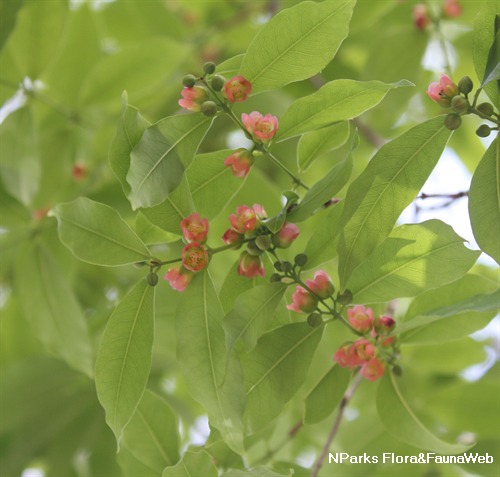
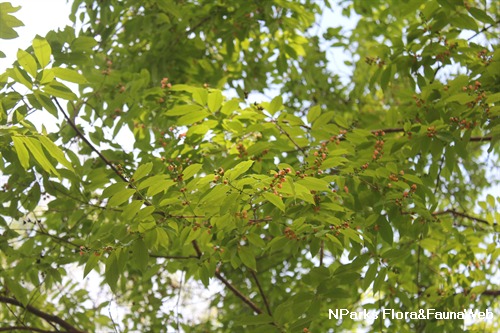
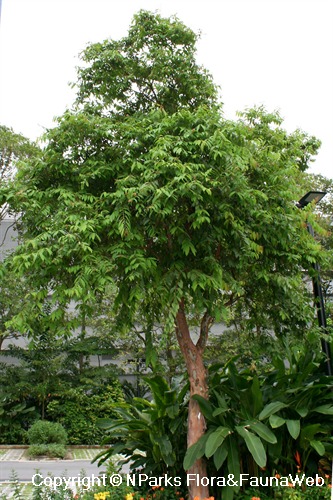
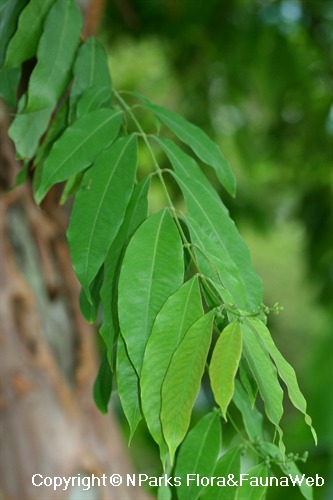
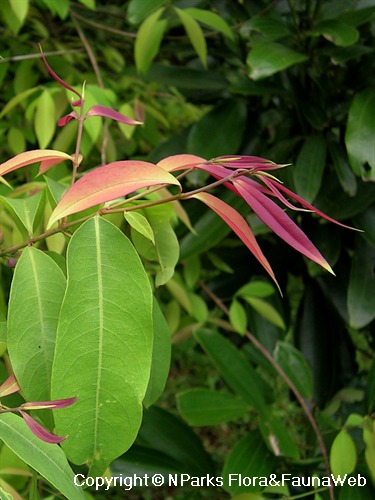
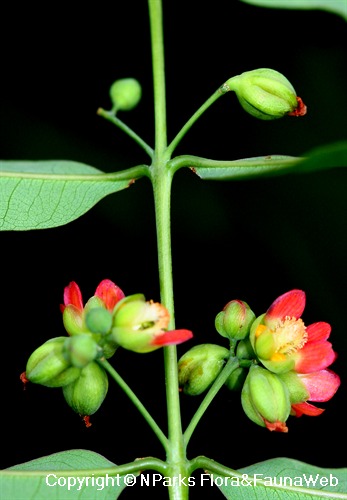
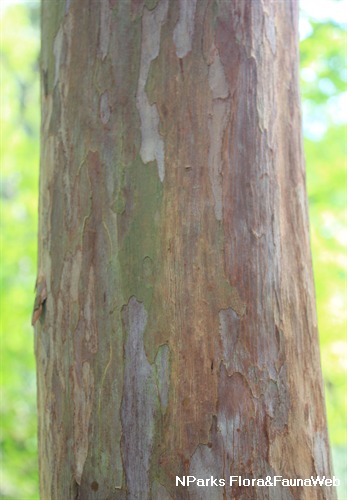
.jpg)

.jpg)
